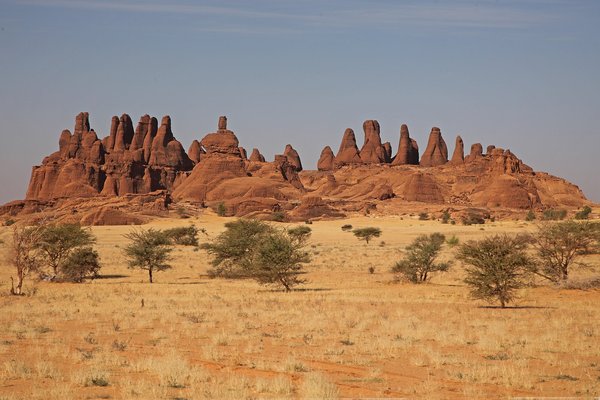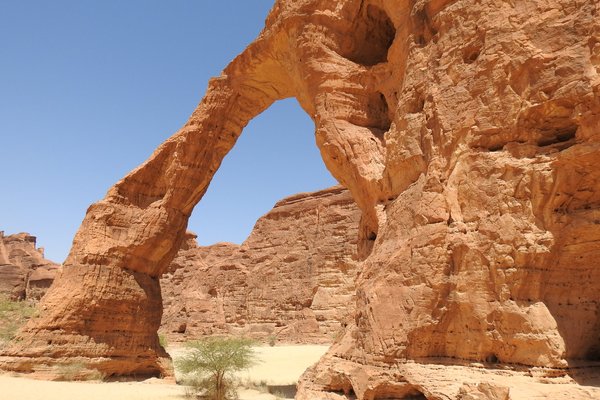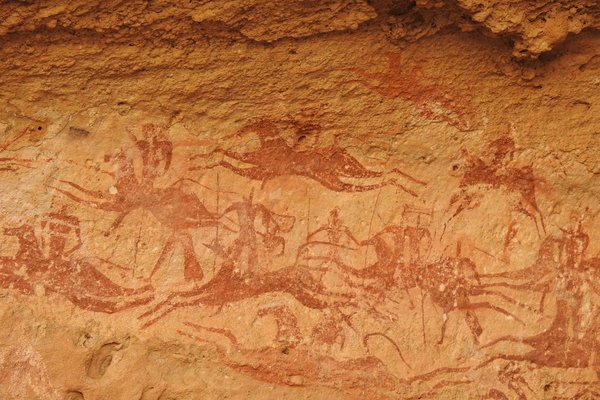Chad
Ennedi Massif
The "Ennedi Massif: Natural and Cultural Landscape" is an eroded mountain massif in the Sahara desert, containing numerous rock paintings and archaeological sites.
The sandstone plateau was sculpted by water and wind erosion, leading to scenically impressive features such as formidable rock arches and pinnacles. Though lying deep in the desert, the area sees regular rain. This results in a varied flora and fauna, and notably in the surviving Nile crocodiles in the permanent pocket of water called Guelta Archei. It became a refuge also for humans, who left rock art there. Nomadic pastoralists are still visiting.
Community Perspective: a difficult but rewarding site to visit, "spectacular in so many different aspects". It takes 3.5 days of solid driving on mostly unpaved roads to get there from the capital. You have it all to yourself, as it is unlikely to encounter any other tourists than the ones you arrived with. The most recent review describes what you may expect from a 4-day stay in the area.
Site Info
Official Information
- Full Name
- Ennedi Massif: Natural and Cultural Landscape (ID: 1475)
- Country
- Chad
- Status
-
Inscribed 2016
Site history
History of Ennedi Massif
- 2016: Revision
- Formerly on T List as: La région d'Archei : le paysage naturel, culturel et son art rupestre
- 2016: Advisory Body overruled
- IUCN and ICOMOS both advised Deferral, mostly because of the reduction in size of the protected area after their visit
- 2016: Inscribed
- Inscribed
- 2015: Incomplete - not examined
- As "Massif de l'Ennedi : paysage naturel et culturel"
- Type
- Mixed
- Criteria
- iii
- vii
- ix
Links
- UNESCO
- whc.unesco.org
- Official
-
- africanparks.org — African Parks Ennedi
- Related
-
- naturalarches.org — Natural Arches of the Ennedi
- mntnfilm.com — Rock climbing movie: Towers of the Ennedi
All Links
UNESCO.org
- whc.unesco.org — whc.unesco.org/
Official Website
- africanparks.org — African Parks Ennedi
Related Resources
- naturalarches.org — Natural Arches of the Ennedi
- mntnfilm.com — Rock climbing movie: Towers of the Ennedi
News Article
- Oct. 8, 2025 africanparks.org — Chad cuts ties with African Parks
- March 20, 2017 enca.com — Chad cave paintings at world heritage site defaced
Community Information
- Community Category
- Natural landscape: Desert
- Cultural Landscape: Continuing
Travel Information
Red Zone Travel Advisory
One thousand visitors or fewer
Recent Connections
-
Hand Paintings or Hand Prints
"There were numerous handprints from b…
-
Red Zone Travel Advisory
All of Chad except for the South -
One thousand visitors or fewer
"“Tourism is little developed in the ar…
Connections of Ennedi Massif
- Individual People
-
-
Sir Wilfred Thesiger
Describes his visit in "A Camel Journey to Tibesti" (1939): "Basking on the edge of these pools I saw six small crocodiles, the largest 5 feet in length."See reseau-tchad.org
-
Visited by Nicolas Hulot
Émission 44 : Tchad - Espoir de vie (Tchad, 2011) -
Théodore Monod
Monod explored the Ennedi Mountains beginning in the 1930s and continuing on several occasions thereafter. He documented spectacular geological formations (arches, canyons), rock paintings, which he studied and championed as a major African heritage, and the remaining Saharan biodiversity, including the last desert crocodile populations. For Monod, this massif embodied the living memory of the Sahara, at once paleoclimatic, cultural, and ecological. He saw it as an open-air museum of the African Neolithic. He helped draw scientific attention to the need to preserve these isolated massifs, which he considered natural and cultural sanctuaries.
-
- Geography
- Trivia
-
-
Cryptozoology
Tiger of EnnediSee fr.wikipedia.org
-
- Ecology
-
-
Natural Arches and Bridges
"very large concentration of rock arches, probably only exceeded by Arches National Park in the USA. With a height of 120 metres, the Aloba stone arch is reportedly the second highest .. in the world" (AB ev) -
Refugium
"With the return of the drier conditions, these fluvial connections dried out and only a small population (of Crocodales) was able to survive in the Ennedi refugium, thanks to the presence of permanent water in the Guelta Archei." (IUCN) -
Crocodiles
"One of the most striking conservation features is the small population of crocodiles, estimated at around 10 individuals, which live in the Guelta Archei" (AB ev)
-
- Damaged
-
-
Threatened by Oil and Gas Exploration
Potential Threat: "The reduction in the area proposed for inscription was triggered by the fact that an oil concession was granted in the area which was removed from the boundaries. While this means that no oil concessions overlap with the boundaries of the site as inscribed, .... Future oil operations in the vicinity of the site may have impacts on the site's integrity and values" (IUCN Outlook 2020)
-
- World Heritage Process
-
-
Reduced from broader TWHS
The property has been reduced during the process twice, the last time excluding the northern part (due to an oil exploration concession?) which could be a future extension.See whc.unesco.org
-
Mixed and Cultural Landscape
Continuing CL
-
- Human Activity
-
-
Iron production
some 30 bases of reduction smelters were found (AB ev) -
Pictographs
"The polychromy of the paintings and the engravings denotes refined techniques. Most of the rock walls were painted or engraved when cattle and sheep farming was practiced" (AB ev) -
Hand Paintings or Hand Prints
"There were numerous handprints from both men and women found among the rock art" (wiki)
-
Pastoralism
In the present day, local communities still practice nomadic pastoralism and a traditional way of life (AB ev) -
African Parks Network
-
- Constructions
-
-
Necropolises
Tumuli grouped in large necropolises easily detectable in the landscape - in Chibi more than 2000 burial sites extend over dozens of hectares (AB ev) -
Tumuli
tumuli grouped in large necropolises (AB ev)
-
- Timeline
-
-
Built in the 5th millennium BC
Rock Art: Sixteen styles and three different periods have been identified: archaic (7,000 - 6,000 BP), bovidian (5,000 - 2,000 BP), and cameline (2,000 BP – present day) (OUV) -
Holocene
originated in what is called the Neolithic Subpluvial or Holocene Wet Phase (wiki nl)
-
- Visiting conditions
-
-
Red Zone Travel Advisory
All of Chad except for the South -
One thousand visitors or fewer
"“Tourism is little developed in the area due to logistical challenges, visitor numbers are currently estimated between 200 to 600 people a year.” (AB ev)"
-
News
- africanparks.org 10/08/2025
- Chad cuts ties with African Parks
- enca.com 03/20/2017
- Chad cave paintings at world herit…
Community Reviews
Show full reviews
The undisputed highlight of any trip to Chad is the Ennedi Massif. This huge sandstone formation has ancient rock art, pre-Islamic burial mounds, contemporary nomadic life, weirdly eroded landforms such as pinnacles, arches and mushrooms, and the iconic canyon Guelta d'Archei. In October 2022 we experienced the area greener than our guide had ever seen it before, thanks to the generous rainy season of this year. Situated deep in the Sahara, it takes 3.5 days of solid driving on mostly unpaved roads to get there from the capital N'Djamena. We stayed for 4 days, wild camping in a different lovely location every night and driving & hiking all day between the sights.
Rock art is everywhere. Some are engravings, but mostly there are clear paintings in red and white. You can crawl into rock shelters and caves to come within touching distance of the rock paintings. I even inadvertently put up my tent next to a rock wall and later noticed there were two camel paintings next door. The most characteristic images of this region are the "flying" camels and horses, some mounted by riders. The best ones are at Terkei (flying horses in red) and Bichagara in West-Ennedi (flying camels in white). One morning we even saw a living flying camel plus a rider speed by our camp!
The eroded landforms resemble parks in Utah such as Arches NP and Monument Valley. They are known by names like the Cathedral and the Labyrinth. We visited arches such …
Keep reading 0 comments
The Archei region, which is now presented under the name "Ennedi Massif: natural and cultural landscape", is also rightly known as "the Saharian Garden of Eden".
Huge sandstone cliffs, pillars, arches, labyrinths, towers, guardians, of all shades of reds, yellows, browns, golds...absolutely AMAZING!
This amazingly well preserved mountain range at the Southern border of the biggest desert in the World, is not only incredibly beautiful: it is also home to some of the most amazing rock art in the World, dating 2000 to 7000 years back, in such vast quantities and so well preserved that it is often refered to as "the open-sky Louvre", after the famous French gallery.
The place is scarcely populated, and mainly by nomads whose life hasn't changed much since their ancestors painted or engraved those rocks. Beautiful place, beautiful people, ancient culture preserved and still alive...the Ennedi is spectacular in so many different aspects.
The Ennedi Massif also hids gems of biodiversity: plants and animals have managed to survive there for more than 4000 years since the Sahara became arid again. The lucky visitor who has an early start can even spot the last Saharian crocodiles in the guelta of Archei!
bear in mind that it is not so easy to get there: one has to fly to the capital of Chad, N'Djamena, then -with an official TO- drive the whole way to the Ennedi (at least 3 full days in a 4x4). There, there is no infrastructure, so you will sleep in a tent, …
Keep reading 0 comments


